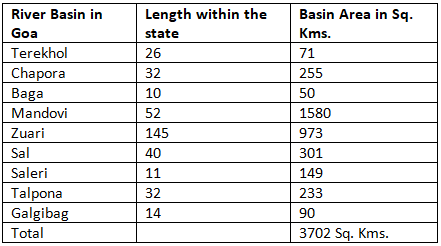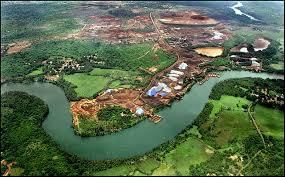GPSC (Goa) Exam > GPSC (Goa) Notes > Goa State PSC (GPSC) Preparation > Goa: Rivers
Goa: Rivers | Goa State PSC (GPSC) Preparation - GPSC (Goa) PDF Download
Drainage systems
- Drainage systems, also known as river systems, refer to the patterns created by streams, rivers, and lakes within a specific drainage basin.
- These patterns are influenced by the terrain of the area, the types of rocks present (whether they are hard or soft), and the slope of the land.

About Rivers of Goa and Drainage
- Goa, the twenty-fifth state of the Indian Union, is a small yet scenic state known globally as "The Tropical Paradise of Tourists."
- Located on the slopes of the Western Ghats to its east and bordered by the Arabian Sea to the west, Goa covers an area of about 3,702 sq km.
- Goa is positioned between Karnataka and Maharashtra.
- It is bounded to the north by the Terekhol River, surrounded by Karnataka to the south and east, and faces the Arabian Sea to the west.
- The state is divided into two districts: North Goa, administered from Panaji, and South Goa, administered from Margao.
- Goa has nine major rivers flowing from east to west, except for the Sal River: Terekhol, Chapora, Baga, Mandovi, Zuari, Sal, Saleri, Talpona, and Galgibag.
- Mandovi and Zuari rivers drain 2,553 sq km, about 70% of Goa’s total geographical area.
- Six of these rivers originate and flow entirely within Goa, while Terekhol and Chapora originate in Maharashtra, and Mandovi originates in Karnataka.
- These rivers are vital to Goan life for their roles in portability, irrigation, agriculture, coastal resources, and transportation of mining ores.
- The rivers of Goa are both tidal and rainfed. During the monsoon, water in the watershed areas drains through the major rivers to the sea.
- Tidal influences extend up to 40 km inland towards the river’s upstream.
- River salinity varies significantly between monsoon and non-monsoon seasons, affecting the physico-chemical quality of water in wells along the riverbanks.

Madovi and Zuari: Two most important Rivers of Goa
- Goa's topographical features are defined by the Mandovi and Zuari rivers.
- Approximately 20,000 years ago, during the last glacial period, the National Institute for Oceanography noted that the Mandovi and Zuari rivers originally formed a unified river system that diverged at a later stage.
Mandovi River
- Origin and Course: The Mandovi River, also known as Mahadayi, originates at an altitude of 600 meters in the primary Sahyadris above the Kelil Ghat in the Degao village of Belgaum district, Karnataka. It flows 29 kilometers through the Uttar Kannada District of Karnataka before entering Goa via Sattari Taluka in North Goa District. Within Goa, it spans 52 kilometers before emptying into the Arabian Sea at Marmagao Bay near Panjim.
- Interstate River: The Mandovi River's catchment area lies in both Goa and Karnataka, making it an interstate river. In Goa, it covers 1,580 square kilometers, which is approximately 42% of the state's area.
- Significance: In the upper reaches of the Sattari valley, the river is known as Mhadei, signifying 'Great Mother.' It merges with the Khandepar River at Bembol (Bicholim) and is referred to as Mandovi until it meets the Arabian Sea near Panaji. The Mhadei River, a crucial tributary of the Mandovi, holds significant ecological importance for the state. Around 85% of the Mhadei watershed is covered by forests and hosts the Mhadei Wildlife Sanctuary.
- Basin Size: The Mandovi River boasts the largest basin in Goa.
Zuari River

- Zuari River: It is the longest river in Goa and has the second-largest basin in the state.
- Historical Name: Zuari was previously known as Aghanashini, meaning "destroyer of sin."
- Source and Course: The river’s source lies entirely within Goa, with the inter-state boundary closely following the water divide. It originates in the Dighi Ghat of the Karnataka part of the Sahyadri Hills, flows in a zigzag pattern for about 145 km, and joins the Arabian Sea at Mormugao-Dona Paula.
- Zuari Basin: Extending from Netravali to Panjim, it covers an area of about 975 sq km, constituting about 27% of Goa’s total area. The basin includes a forest area of 31.4% and hosts the Netravali Wildlife Sanctuary.
- Usage: The waters of the Mandovi and Zuari rivers are extensively used for drinking and agricultural purposes. Mandovi also serves as a crucial internal navigation route for commercial activities.
- Cities: Panaji, the state capital, and Old Goa, the former capital, are both located on the left bank of the Mandovi River.
Terekhol River
- The Terekhol River, located in western India, originates as the Banda River in its upper stretches before transforming into the Terekhol River in the lower regions.
- Serving as a natural boundary, this river demarcates the border between the Sindhudurg district of Maharashtra and the North Goa district of Goa for a considerable distance.
- Originating near Manohargad in the Western Ghats, the Terekhol River flows in a south-westerly direction until it meets the Arabian Sea.
- Nestled on the northern bank of the river lies the historic Terekhol fort, a prominent landmark in the far north of Goa.
- Accessible by ferry from Kerim, a mere 2 km journey leads to the fort, offering a glimpse into the region's rich history and scenic beauty.
Chapora River
- The Chapora River, situated in northern Goa, India, flows westward and converges with the Arabian Sea at Chapora, delineating the boundary between the North Goa talukas of Pernem and Bardez.
- Originating at Ramghat in Maharashtra, the river traverses into Goa before emptying into the Arabian Sea.
- Along its course, the river showcases picturesque landscapes, with Vagator Beach serving as a popular tourist spot at its estuary, while the village of Morjim lies to the north.
- Connected by a bridge, Morjim and Siolim provide access across the river, facilitating transportation and enhancing connectivity in the region.
- Historically significant, the Chapora River once delineated the boundary between Portuguese Goa and India during the 18th century, reflecting its cultural and geopolitical relevance.
Sal River
- Location: The Sal River is a small river in Salcete, Goa, India.
- Course: It flows near Margao, passing through villages such as Benaulim, Navelim, Varca, Orlim, Carmona, Dramapur, Chinchinim, Assolna, Cavelossim, and Mobor before draining into the Arabian Sea at Betul.
- Pollution Issues: Local residents of Benaulim have complained about pollution and garbage dumping into the river since 2008. Additionally, residents of Carmona have petitioned Greenpeace to halt a “mega-housing project” that could exacerbate pollution.
Mapusa River
- Tributary: The Mapusa River is a tributary of the Mandovi River in Goa, India.
- Origin and Course: It originates from the jungles of Dumacem and Amthane, meandering eastward and then southward before flowing into the Mandovi River at Penha de France.
- Historical Use: The river has historically been used as a waterway for transporting agricultural products and spices.
- Mapusa Town: The town of Mapusa, the largest town on the banks of Goa’s rivers, is located along the Mapusa River.
Question for Goa: RiversTry yourself: Which river in Goa has the largest basin size?View Solution
The document Goa: Rivers | Goa State PSC (GPSC) Preparation - GPSC (Goa) is a part of the GPSC (Goa) Course Goa State PSC (GPSC) Preparation.
All you need of GPSC (Goa) at this link: GPSC (Goa)
FAQs on Goa: Rivers - Goa State PSC (GPSC) Preparation - GPSC (Goa)
| 1. What are the two most important rivers of Goa? |  |
Ans. The two most important rivers of Goa are Madovi and Zuari.
| 2. What is the significance of the drainage systems in Goa? |  |
Ans. Drainage systems in Goa are important for managing water flow, preventing flooding, and maintaining the ecosystem's health.
| 3. How do the rivers of Goa contribute to the region's landscape? |  |
Ans. The rivers of Goa provide a picturesque landscape, supporting diverse flora and fauna, and offering opportunities for recreational activities.
| 4. What are some common issues related to the rivers and drainage in Goa? |  |
Ans. Some common issues related to the rivers and drainage in Goa include pollution, encroachment, and the impact of development on the natural environment.
| 5. How does the government of Goa manage the rivers and drainage systems in the region? |  |
Ans. The government of Goa implements various policies and projects to conserve and protect the rivers and drainage systems, ensuring sustainable development and environmental preservation.
Related Searches




















